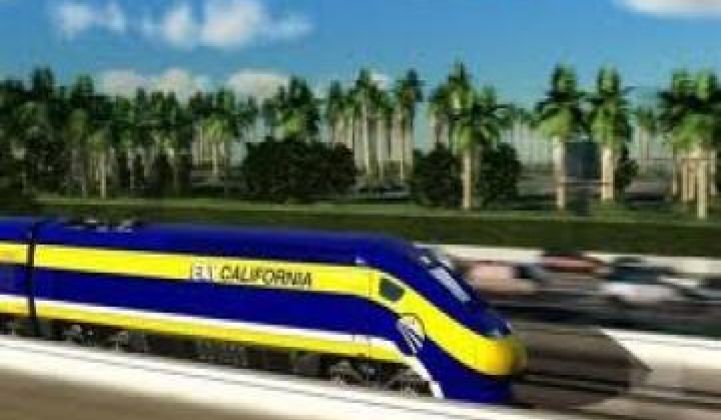Earlier this month, Scott Walker, Republican Governor-elect of Wisconsin, vowed to reject $810 million in federal stimulus funds that were meant to go to a high-speed train to be built between Milwaukee and Madison.
Instead of the “boondoggle” of high-speed rail, as Walker calls it on the website dedicated to not having high-speed rail, he calls for the money to go instead to road projects. Walker is not alone. John Kasich, Governor-elect of Ohio, has also asked to use the $400 million allocated to his state for road construction and freight lines.
Enter California. On the heels of Secretary of Transportation Ray LaHood’s announcement that the money must either be used for high-speed rail or returned, Gov. Arnold Schwarzenegger sent a letter to LaHood letting him know that “you are more than welcome to redirect that money to California -- where we know how to use it to generate hundreds of thousands of jobs and provide a clean, fast and low-cost way to travel.”
But cost is at the heart of the issue. Walker argues that Wisconsin can’t afford to operate the train once it is constructed. However, there is no form of transportation that is not subsidized in some way. Ultimately, the question is where government dollars are best spent.
While there are some questions in California about right-of-ways and the ultimate cost of a modern HSR train that will run at 220 mph, residents still passed a $9.9 billion bond in 2008 and the state has continued to get sizeable chunks of stimulus funds for their project because they are further along with environmental assessment impacts than some other states.
Also, the train in California will be truly high-speed, grade-separated, and will cut down on air congestion. In France and Spain, as HSR networks were built, regional air traffic was cut at least in half.
In the approximately 80-mile corridor between Milwaukee and Madison, the advantages of rail travel versus air travel are less obvious. The system will be fast, but hardly what Europeans consider HSR. It will top off at about 110 mph, and operate at about 80 to 90 mph, according to the plan.
However, even though it won’t be a bullet train, Walker is already seeing backlash over rejecting the funds, which will simply be reallocated to California or other states that make a bid for it.
The Minnesota AFL-CIO has called for him to change his mind. Also, tourism is one of the top three economic sectors in Wisconsin, and having a train that connects two major cities could help to bring more tourism dollars to the state. Spain also found that connecting cities that had experienced economic disadvantage reinvigorated those places, bringing new business and residents to both communities.
Business opportunities in Wisconsin may already be lost if there are no plans for HSR. Talgo, a Spanish train builder, had already committed to opening a factory in Milwaukee, but without the train, the company said it would only stay through 2012 and then take its business elsewhere.
The decision made by Walker also means that Wisconsin might be cut off from the larger planned HSR network in the Midwest, which would connect to Chicago and the Twin Cities.
The clock is already ticking for Walker to change his mind or cough up the money. “Unless you change your position,” LaHood wrote to the Governor-elect, “we plan to engage in an orderly transition to wind down Wisconsin’s project.”
Mobility

California Reaches for Rejected Rail Money
Can California scoop up nearly $1B because Wisconsin’s governor-elect hates high-speed rail?

California Reaches for Rejected Rail Money
-
41Where Will DOE’s Loan Program Make the Next Climate Tech Investments?
-
15What the Frack Is Happening With Natural Gas Prices?
-
9With an Energy Crisis Brewing, No Peak in Sight for Emissions


